Application of Artificial Neural Network Based on Traditional Detection and GC-MS in Prediction of Free Radicals in Thermal Oxidation of Vegetable Oil
Abstract
:1. Introduction
2. Results and Discussion
2.1. Free Radical Analysis under Thermal Process
2.2. EPR Analysis of Oxidation Behavior
2.3. Analysis of Chemical Properties and Fatty Acid Composition
2.4. Analysis of Degradation Products
2.5. Model Establishment and Verification by ANN
3. Materials and Methods
3.1. Materials
3.2. Preparation of Purified Oils
3.3. Thermal Oxidation of Oils
3.4. Detection of Fatty Acid Composition
3.5. Analysis of the Chemical Properties and Fatty Acid Composition of Oils
3.6. Oils Analysis by EPR
3.7. Volatile Compounds Analysis by Head Space Solid Phase Microextraction GC-MS
3.8. Uncertainty Measurement of ANN Model
3.9. Statistical Analysis
4. Conclusions
Author Contributions
Funding
Institutional Review Board Statement
Informed Consent Statement
Data Availability Statement
Acknowledgments
Conflicts of Interest
Sample Availability
References
- Roszkowska, B.; Tańska, M.; Czaplicki, S.; Konopka, I. Variation in the composition and oxidative stability of commercial rapeseed oils during their shelf life. Eur. J. Lipid Sci. Technol. 2015, 117, 673–683. [Google Scholar] [CrossRef]
- Martínez-Yusta, A.; Guillén, M.D. A study by 1H nuclear magnetic resonance of the influence on the frying medium composition of some soybean oil-food combinations in deep-frying. Food Res. Int. 2014, 55, 347–355. [Google Scholar] [CrossRef]
- Lazaridi, E.; Janssen, H.-G.; Vincken, J.P.; Pirok, B.; Hennebelle, M. A comprehensive two-dimensional liquid chromatography method for the simultaneous separation of lipid species and their oxidation products. J. Chromatogr. A 2021, 1644, 462106. [Google Scholar] [CrossRef] [PubMed]
- Yuan, L.; Xu, Z.; Tan, C.P.; Liu, Y.; Xu, Y.J. Biohazard and dynamic features of different polar compounds in vegetable oil during thermal oxidation. LWT-Food Sci. Technol. 2021, 146, 111450. [Google Scholar] [CrossRef]
- Garcia-Mendoza, M.; Espinosa-Pardo, F.A.; Savoire, R.; Harscoat-Schiavo, C.; Cansell, M.; Subra-Paternault, P. Improvement of the oxidative stability of camelina oil by enrichment with phospholipid-quercetin formulations. Food Chem. 2020, 341, 128234. [Google Scholar] [CrossRef] [PubMed]
- Zhang, Q.; Saleh, A.S.M.; Chen, J.; Shen, Q. Chemical alterations taken place during deep-fat frying based on certain reaction products: A review. Chem. Phys. Lipids 2012, 165, 662–681. [Google Scholar] [CrossRef]
- Kowalski, R.; Kowalska, G.; Pankiewicz, U.; Mazurek, A.; Sujka, M.; Włodarczyk-Stasiak, M.; Kałwa, K. Effect of the method of rapeseed oil aromatisation with rosemary Rosmarinus officinalis L. on the content of volatile fraction. LWT-Food Sci. Technol. 2018, 95, 40–46. [Google Scholar] [CrossRef]
- Wei, F.; Mei, Y.; Qi, Z.; Chang, Z.; Chen, H. Varietal and processing effects on the volatile profile of rapeseed oils. LWT-Food Sci. Technol. 2012, 48, 323–329. [Google Scholar] [CrossRef]
- Krist, S.; Stuebiger, G.; Bail, S.; Unterweger, H. Analysis of volatile compounds and triacylglycerol composition of fatty seed oil gained from flax and false flax. Eur. J. Lipid Sci. Technol. 2006, 108, 48–60. [Google Scholar] [CrossRef]
- Dun, Q.; Yao, L.; Deng, Z.; Li, H.; Li, J.; Fan, Y.; Zhang, B. Effects of hot and cold-pressed processes on volatile compounds of peanut oil and corresponding analysis of characteristic flavor components. LWT-Food Sci. Technol. 2019, 112, 107648. [Google Scholar] [CrossRef]
- Gertz, C. Fundamentals of the frying process. Eur. J. Lipid Sci. Technol. 2014, 116, 669–674. [Google Scholar] [CrossRef]
- Guillen, M.D.; Goicoechea, E. Oxidation of corn oil at room temperature: Primary and secondary oxidation products and determination of their concentration in the oil liquid matrix from 1H nuclear magnetic resonance data. Food Chem. 2009, 116, 183–192. [Google Scholar] [CrossRef]
- Gu, H.; Huang, X.; Sun, Y.; Chen, Q.; Wei, Z.; Lv, R. Intelligent evaluation of total polar compounds (TPC) content of frying oil based on fluorescence spectroscopy and low-field NMR. Food Chem. 2021, 342, 128242. [Google Scholar] [CrossRef] [PubMed]
- Cho, L.K.; Kim, S.; Khurana, H.K.; Li, Q.X.; Jun, S. Quantification of trans fatty acid content in French fries of local food service retailers using attenuated total reflection—Fourier transform infrared spectroscopy. Food Chem. 2011, 125, 1121–1125. [Google Scholar] [CrossRef]
- Ubhayasekera, S.; Dutta, P.C. Assessment of sterol oxidation in oils recovered from exhausted bleaching earth by coupled capillary column GC and GC–MS methods. J. Am. Oil Chem. Soc. 2012, 89, 1427–1433. [Google Scholar] [CrossRef]
- Carrieri, G.; Anese, M.; Quarta, B.; Bonis, M.; Ruocco, G. Evaluation of acrylamide formation in potatoes during deep-frying: The effect of operation and configuration. J. Food Eng. 2010, 98, 141–149. [Google Scholar] [CrossRef]
- Fan, Z.; Krahl, J. Determination of oxidation stability and degradation degree of rapeseed oil methyl ester by fluorescence spectroscopy. Fuel 2017, 195, 123–130. [Google Scholar] [CrossRef]
- Juita; Dlugogorski, B.Z.; Kennedy, E.M.; Mackie, J.C. Mechanism of formation of volatile organic compounds from oxidation of linseed oil. Ind. Eng. Chem. Res. 2012, 51, 5653–5661. [Google Scholar] [CrossRef]
- Budilarto, E.S.; Kamal-Eldin, A. The supramolecular chemistry of lipid oxidation and antioxidation in bulk oils. Eur. J. Lipid Sci. Technol. 2015, 117, 1095–1137. [Google Scholar] [CrossRef] [Green Version]
- Singkhonrat, J.; Sriprai, A.; Hirunwatthanakasem, S.; Angkuratipakorn, T.; Preechaburana, P. Digital image colorimetric analysis for evaluating lipid oxidation in oils and its emulsion. Food Chem. 2019, 286, 703–709. [Google Scholar] [CrossRef]
- Xia, W.; Budge, S.M. Techniques for the analysis of minor lipid oxidation products derived from triacylglycerols: Epoxides, alcohols, and ketones. Compr. Rev. Food Sci. Food Saf. 2017, 16, 735–758. [Google Scholar] [CrossRef] [PubMed] [Green Version]
- Pingret, D.; Durand, G.; Fabiano-Tixier, A.S.; Rockenbauer, A.; Ginies, C.; Chemat, F. Degradation of edible oil during food processing by ultrasound: Electron paramagnetic resonance, physicochemical, and sensory appreciation. J. Agric. Food Chem. 2012, 60, 7761–7768. [Google Scholar] [CrossRef]
- Chen, H.; Cao, P.; Li, B.; Sun, D.; Wang, Y.; Li, J.; Liu, Y. Effect of water content on thermal oxidation of oleic acid investigated by combination of EPR spectroscopy and SPME-GC-MS/MS. Food Chem. 2017, 221, 1434–1441. [Google Scholar] [CrossRef] [PubMed]
- Sun, Q.; Min, Z.; Mujumdar, A.S.; Yaang, P. Combined LF-NMR and artificial intelligence for continuous real-time monitoring of carrot in microwave vacuum drying. Food Bioprocess Technol. 2019, 12, 551–562. [Google Scholar] [CrossRef]
- Mahjoorian, A.; Mokhtarian, M.; Fayyaz, N.; Rahmati, F.; Sayyadi, S.; Ariaii, P. Modeling of drying kiwi slices and its sensory evaluation. Food Sci. Nutr. 2017, 5, 466–473. [Google Scholar] [CrossRef] [PubMed]
- Husna, M.; Purqon, A. Pediction of dried durian moisture content using artificial neural networks. J. Phys. Conf. Ser. 2016, 739, 012077. [Google Scholar] [CrossRef]
- Sun, Y.; Zhang, M.; Bhandari, B.; Yang, P. Intelligent detection of flavor changes in ginger during microwave vacuum drying based on LF-NMR. Food Res. Int. 2019, 119, 417–425. [Google Scholar] [CrossRef]
- Sun, Q.; Zhang, M.; Yang, P. Combination of LF-NMR and BP-ANN to monitor water states of typical fruits and vegetables during microwave vacuum drying. LWT-Food Sci. Technol. 2019, 116, 108548. [Google Scholar] [CrossRef]
- Le, N.Q.K.; Huynh, T. Identifying SNAREs by incorporating deep learning architecture and amino acid embedding representation. Front. Physiol. 2019, 10, 1501. [Google Scholar] [CrossRef]
- Do, D.T.; Le, T.Q.T.; Le, N.Q.K. Using deep neural networks and biological subwords to detect protein S-sulfenylation sites. Brief. Bioinform. 2020, 22, bbaa128. [Google Scholar] [CrossRef]
- Symoniuk, E.; Ratusz, K.; Krygier, K. Evaluation of the oxidative stability of cold-pressed rapeseed oil by rancimat and pressure differential scanning calorimetry measurements. Eur. J. Lipid Sci. Technol. 2019, 121, 1800017. [Google Scholar] [CrossRef]
- Roman, O.; Courtois, F.; Maillard, M.N.; Riquet, A.M. Kinetic study of hydroperoxide degradation in edible oils using electron spin resonance spectroscopy. J. Am. Oil Chem. Soc. 2012, 89, 1409–1417. [Google Scholar] [CrossRef]
- Qian, S.Y.; Wang, H.P.; Schafer, F.Q.; Buettner, G.R. EPR detection of lipid-derived free radicals from PUFA, LDL, and cell oxidations. Free Radic. Biol. Med. 2000, 29, 568–579. [Google Scholar] [CrossRef]
- Liu, Y.; Wang, Y.; Cao, P.; Liu, Y. Combination of gas chromatography-mass spectrometry and electron spin resonance spectroscopy for analysis of oxidative stability in soybean oil during deep-frying process. Food Anal. Methods 2018, 11, 1485–1492. [Google Scholar] [CrossRef]
- Velasco, J.; Andersen, M.L.; Skibsted, L.H. Evaluation of oxidative stability of vegetable oils by monitoring the tendency to radical formation. A comparison of electron spin resonance spectroscopy with the Rancimat method and differential scanning calorimetry. Food Chem. 2004, 85, 623–632. [Google Scholar] [CrossRef]
- Rossi, M.; Alamprese, C.; Ratti, S. Tocopherols and tocotrienols as free radical-scavengers in refined vegetable oils and their stability during deep-fat frying. Food Chem. 2007, 102, 812–817. [Google Scholar] [CrossRef]
- Fujisaki, M.; Endo, Y.; Fujimoto, K. Retardation of volatile aldehyde formation in the exhaust of frying oil by heating under low oxygen atmospheres. J. Am. Oil Chem. Soc. 2002, 79, 909–914. [Google Scholar] [CrossRef]
- Kim, T.S.; Yeo, J.D.; Ji, Y.K.; Kim, M.J.; Lee, J.H. Determination of the degree of oxidation in highly-oxidised lipids using profile changes of fatty acids. Food Chem. 2013, 138, 1792–1799. [Google Scholar] [CrossRef]
- Porter, N.A.; Caldwell, S.E.; Mills, K.A. Mechanisms of free radical oxidation of unsaturated lipids. Lipids 1995, 30, 277–290. [Google Scholar] [CrossRef]
- Xu, L.; Yu, X.; Li, M.; Jia, C.; Wang, X. Monitoring oxidative stability and changes in key volatile compounds in edible oils during ambient storage through HS-SPME/GC–MS. Int. J. Food Prop. 2017, 20, S2926–S2938. [Google Scholar] [CrossRef] [Green Version]
- Liu, Y.; Li, J.; Cheng, Y.; Liu, Y. Effect of frying oils’ fatty acid profile on quality, free radical and volatiles over deep-frying process: A comparative study using chemometrics. LWT-Food Sci. Technol. 2019, 101, 331–341. [Google Scholar] [CrossRef]
- Nieva-Echevarría, B.; Manzanos, M.J.; Goicoechea, E.; Guillén, M.D. Changes provoked by boiling, steaming and sous-vide cooking in the lipid and volatile profile of European sea bass. Food Res. Int. 2017, 99, 630–640. [Google Scholar] [CrossRef] [PubMed]
- Wang, P.; Fan, E.; Wang, P. Comparative analysis of image classification algorithms based on traditional machine learning and deep learning. Pattern Recognit. Lett. 2020, 141, 61–67. [Google Scholar] [CrossRef]
- Chen, H.; Wang, Y.; Cao, P.; Liu, Y. Effect of temperature on thermal oxidation of palmitic acid studied by combination of EPR spin trapping technique and SPME-GC-MS/MS. Food Chem. 2017, 234, 439–444. [Google Scholar] [CrossRef]
- Firestone, D. Official Methods and Recommended Practices of the AOCS; American Oil Chemists’ Society: Urbana, IL, USA, 2009. [Google Scholar]
- Abbaspour, K.C.; Johnson, C.A.; Genuchten, M. Estimating uncertain flow and transport parameters using a sequential uncertainty fitting procedure. Vadose Zone J. 2004, 3, 1340–1352. [Google Scholar] [CrossRef]


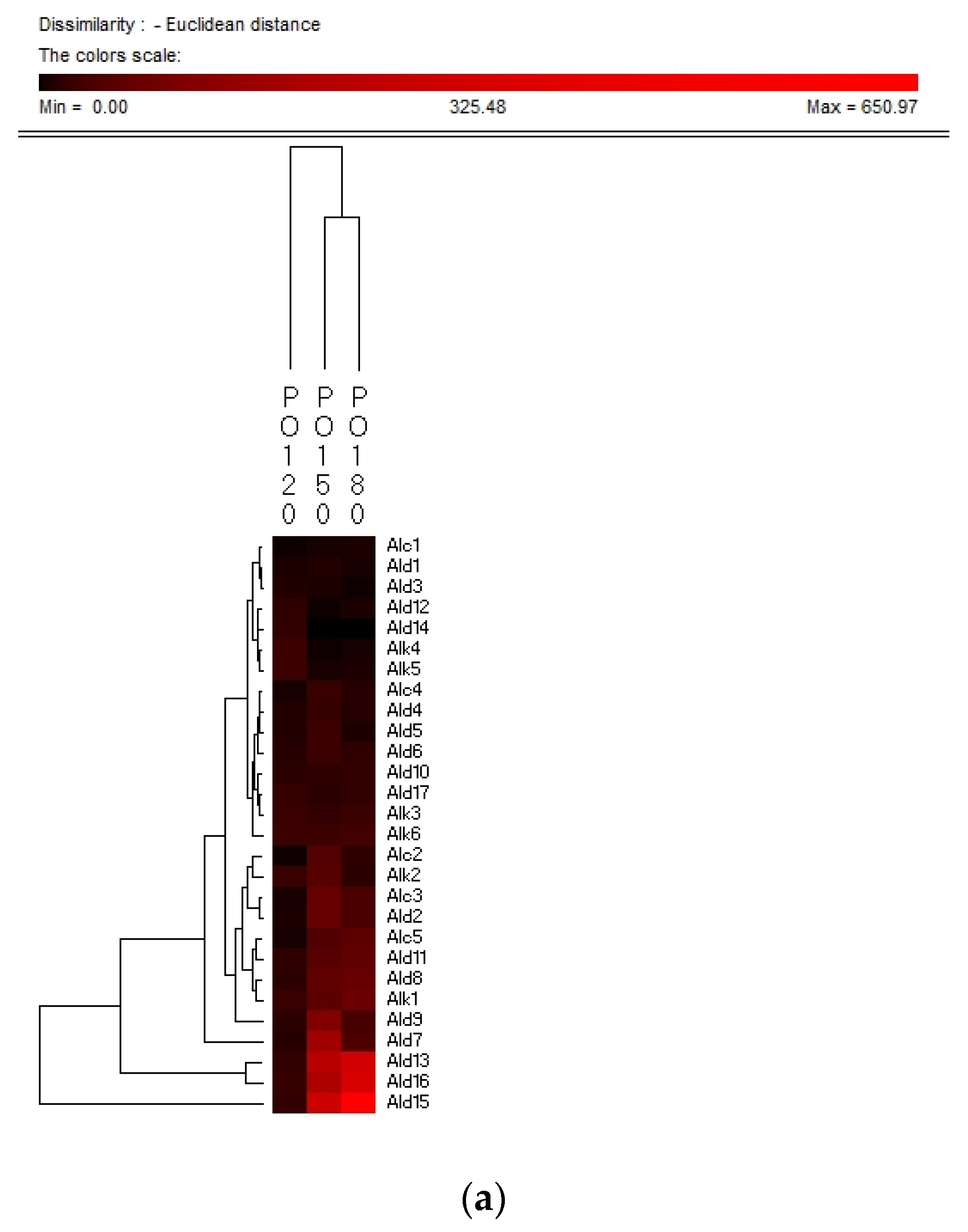
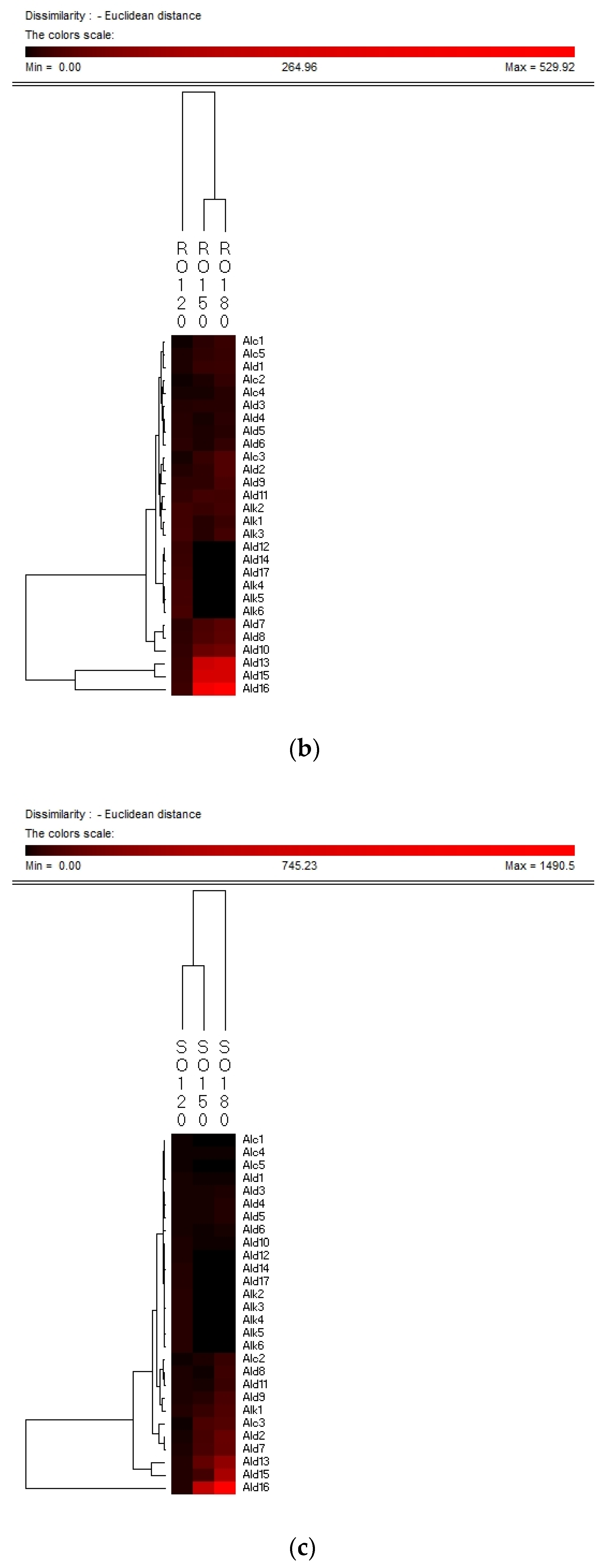
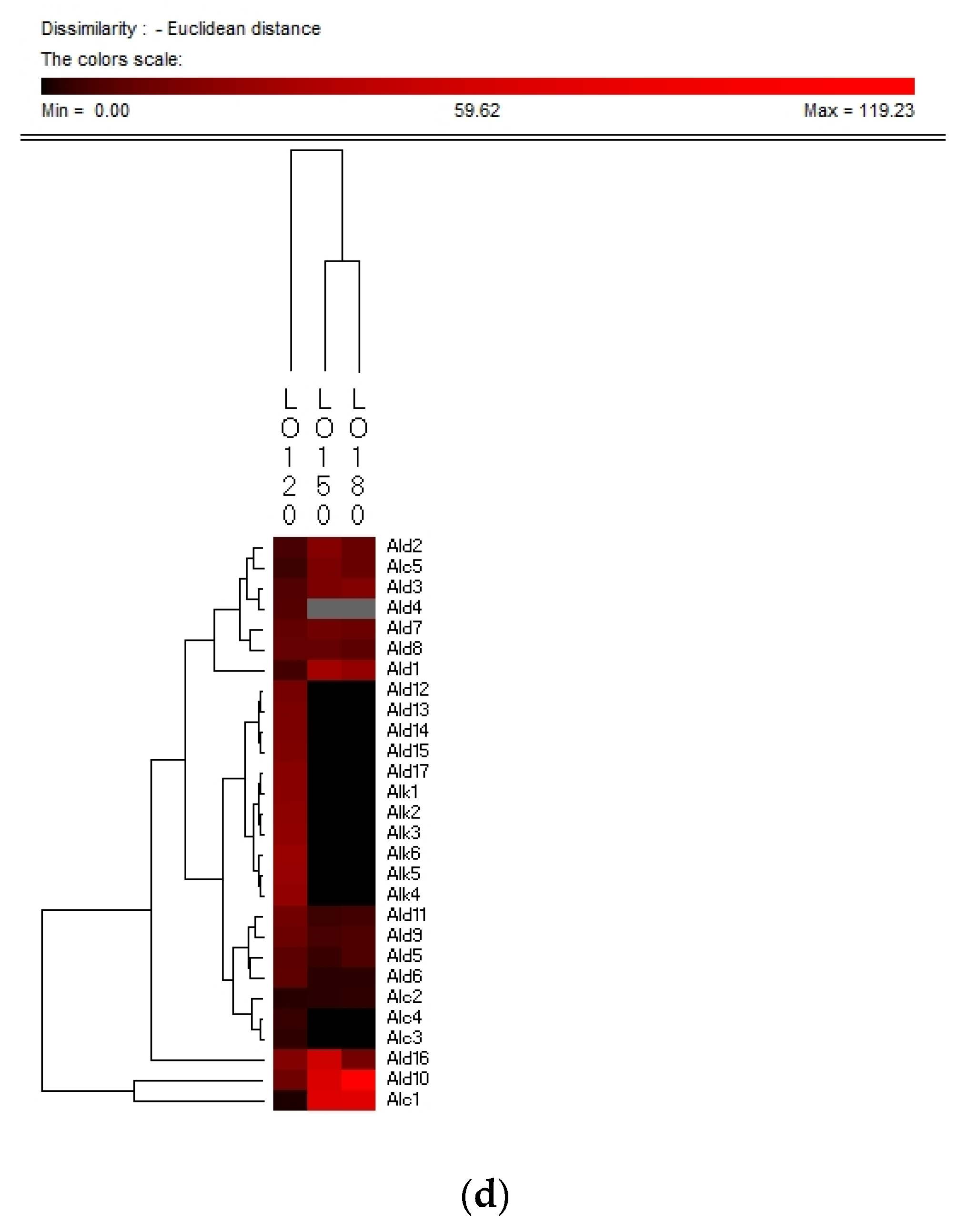
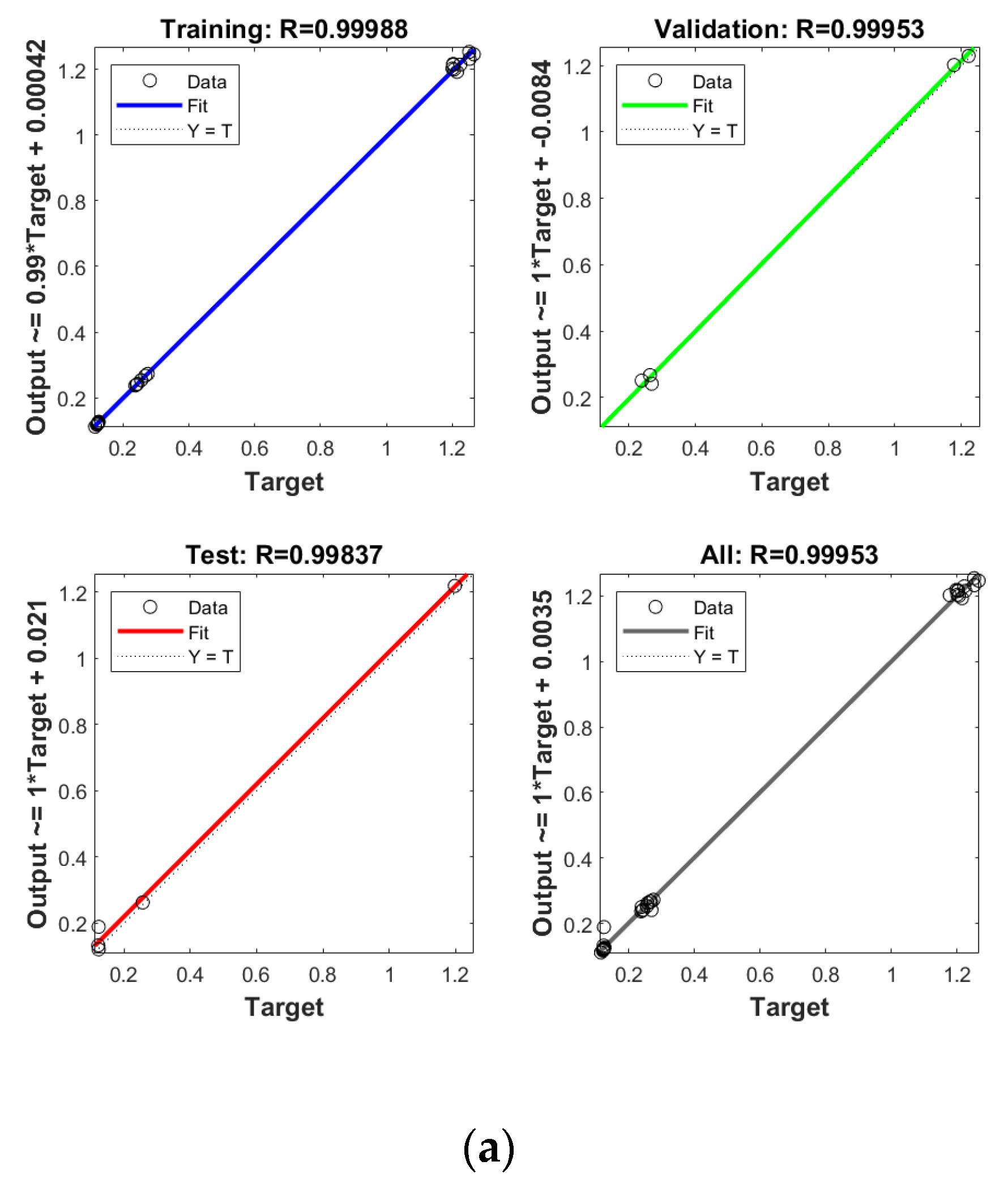
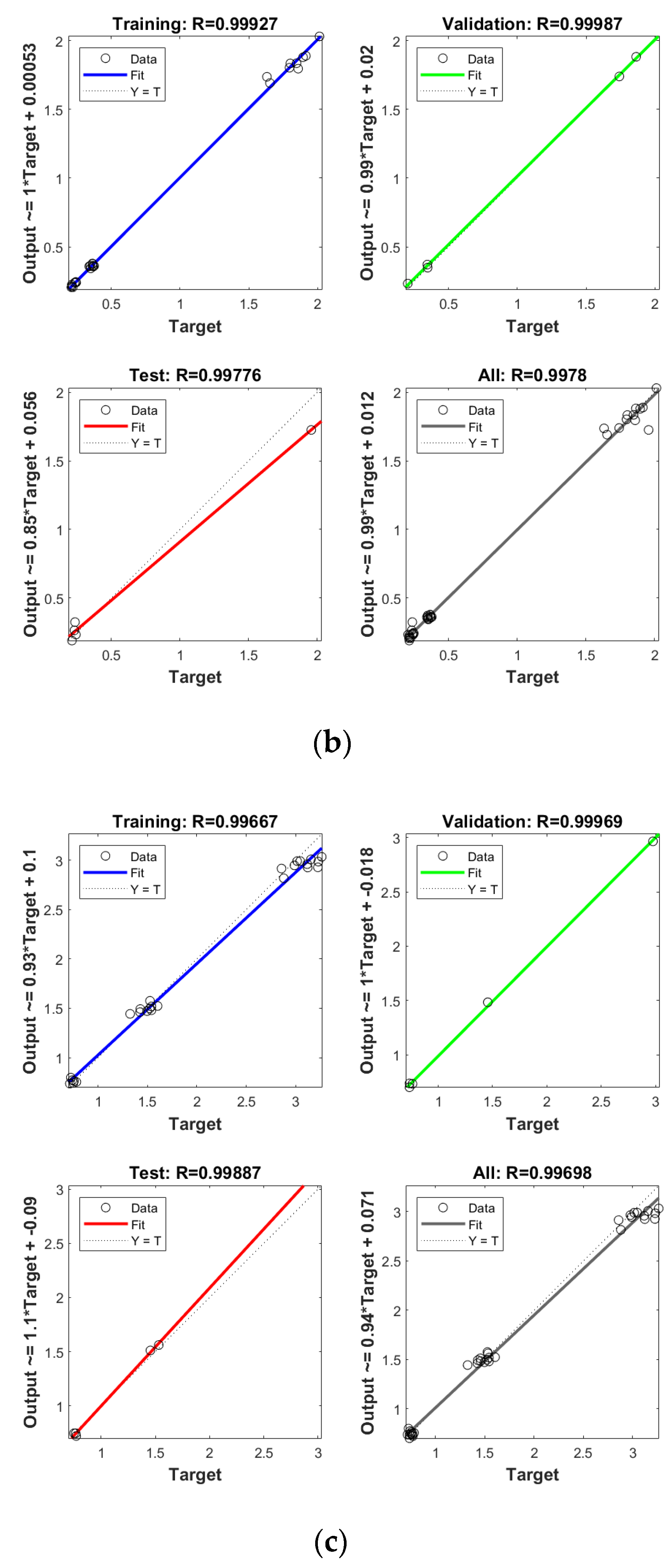
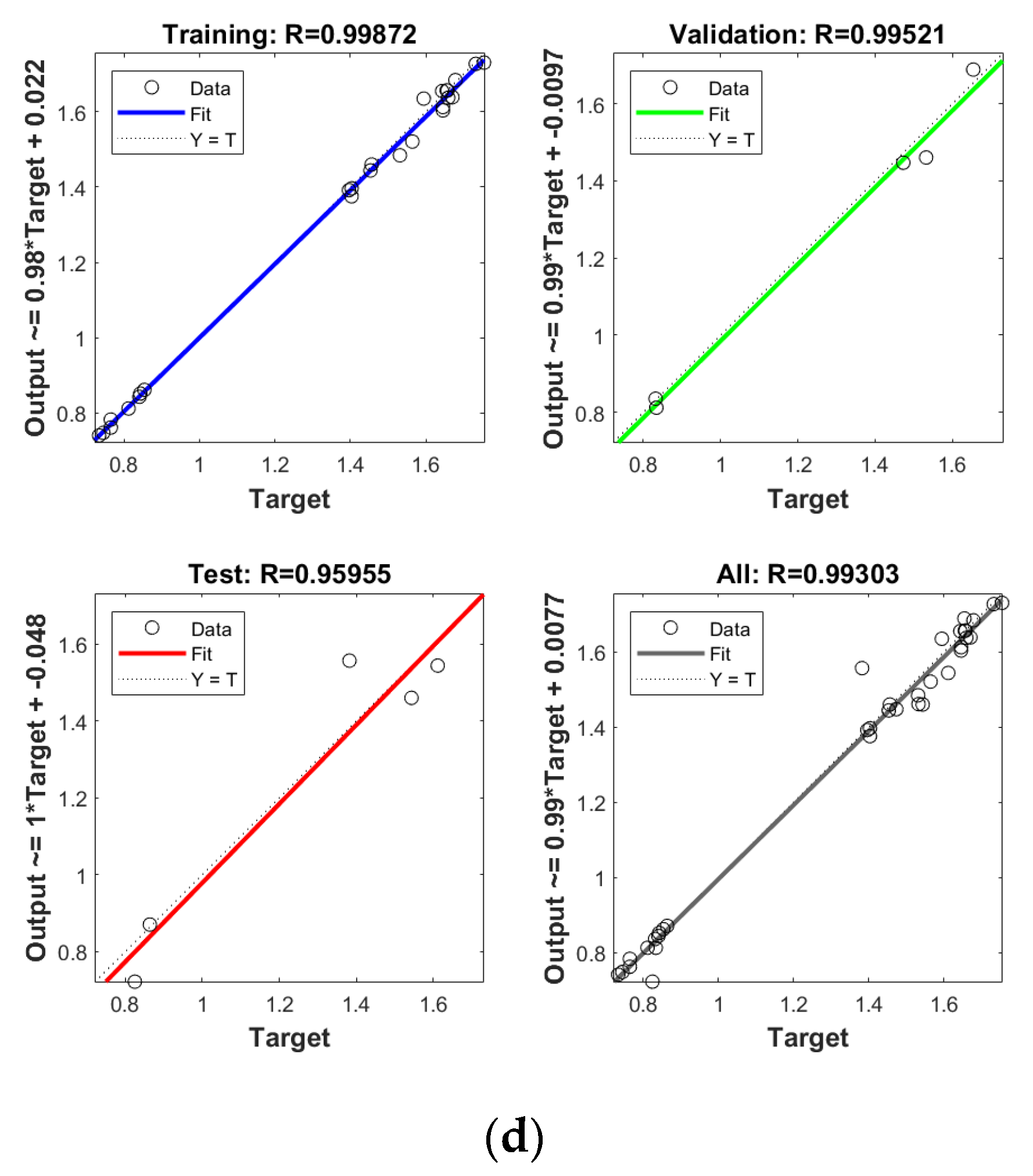
| Oil | PO | RO | SO | LO |
|---|---|---|---|---|
| OSI (h) | 13.06 | 8.85 | 2.42 | 0.75 |
| Oil Type | Heating Temperature (°C) | AV (mg/g) | PV (mmol/kg) | p-AV | Main Fatty Acids (mg/100 mg) | ||||
|---|---|---|---|---|---|---|---|---|---|
| C16:0 | C18:0 | C18:1 | C18:2 | C18:3(n−3) | |||||
| PO | Unheated | 0.33 ± 0.03 | 0.50 ± 0.18 | 3.15 ± 0.12 | 29.29 ± 0.68 | 3.59 ± 0.12 | 33.56 ± 1.02 | 8.12 ± 0.11 | 0.11 ± 0.001 |
| 120 | 3.36 ± 0.15 | 53.28 ± 2.36 | 54.84 ± 2.11 | 24.71 ± 0.07 | 3.22 ± 0.10 | 30.15 ± 0.03 | 6.42 ± 0.00 | 0.09 ± 0.001 | |
| 150 | 4.89 ± 0.13 | 5.13 ± 0.02 | 76.26 ± 1.81 | 26.33 ± 0.06 | 3.20 ± 0.03 | 29.92 ± 0.06 | 6.02 ± 0.01 | 0.08 ± 0.001 | |
| 180 | 7.21 ± 0.13 | 5.87 ± 0.22 | 126.14 ± 1.01 | 27.02 ± 0.04 | 3.27 ± 0.03 | 28.75 ± 0.08 | 5.29 ± 0.03 | 0.04 ± 0.001 | |
| RO | Unheated | 0.26 ± 0.01 | 0.75 ± 0.05 | 4.07 ± 0.16 | 2.69 ± 0.01 | 1.51 ± 0.01 | 46.29 ± 1.21 | 16.22 ± 0.41 | 5.15 ± 0.62 |
| 120 | 4.21 ± 0.23 | 62.86 ± 0.12 | 109.16 ± 3.51 | 2.72 ± 0.09 | 1.32 ± 0.01 | 40.82 ± 0.10 | 13.31 ± 0.02 | 4.89 ± 0.34 | |
| 150 | 5.98 ± 0.18 | 3.36 ± 0.06 | 125.70 ± 3.51 | 2.57 ± 0.12 | 1.45 ± 0.10 | 40.74 ± 0.08 | 13.01 ± 0.08 | 4.26 ± 0.41 | |
| 180 | 8.35 ± 0.25 | 2.54 ± 0.01 | 230.70 ± 3.84 | 2.71 ± 0.14 | 1.46 ± 0.06 | 41.99 ± 0.11 | 12.10 ± 0.02 | 3.32 ± 0.33 | |
| SO | Unheated | 0.22 ± 0.00 | 2.03 ± 0.01 | 5.61 ± 0.28 | 3.89 ± 0.02 | 3.25 ± 0.02 | 13.62 ± 0.34 | 51.87 ± 1.52 | 0.22 ± 0.03 |
| 120 | 4.56 ± 0.15 | 59.14 ± 0.16 | 101.37 ± 1.98 | 3.87 ± 0.11 | 3.18 ± 0.03 | 13.25 ± 0.01 | 49.14 ± 0.05 | 0.09 ± 0.001 | |
| 150 | 6.56 ± 0.19 | 6.45 ± 0.01 | 153.60 ± 10.73 | 3.89 ± 0.04 | 3.30 ± 0.05 | 13.08 ± 0.01 | 47.77 ± 0.03 | 0.06 ± 0.001 | |
| 180 | 8.79 ± 0.20 | 2.69 ± 0.15 | 207.26 ± 2.07 | 3.76 ± 0.01 | 3.26 ± 0.01 | 12.75 ± 0.01 | 45.53 ± 0.03 | 0.05 ± 0.001 | |
| LO | Unheated | 0.27 ± 0.02 | 2.78 ± 0.03 | 3.65 ± 0.01 | 3.12 ± 0.01 | 2.76 ± 0.02 | 13.15 ± 0.28 | 11.96 ± 0.38 | 41.02 ± 1.18 |
| 120 | 5.75 ± 0.16 | 20.62 ± 0.05 | 109.16 ± 9.67 | 2.97 ± 0.03 | 2.61 ± 0.01 | 12.53 ± 0.02 | 11.24 ± 0.01 | 37.85 ± 0.05 | |
| 150 | 8.42 ± 0.21 | 5.23 ± 0.14 | 211.90 ± 0.07 | 3.03 ± 0.03 | 2.55 ± 0.01 | 11.93 ± 0.01 | 10.66 ± 0.01 | 33.33 ± 0.08 | |
| 180 | 10.45 ± 0.20 | 6.70 ± 0.04 | 363.47 ± 11.18 | 3.08 ± 0.09 | 2.51 ± 0.05 | 11.49 ± 0.09 | 10.03 ± 0.02 | 28.79 ± 0.11 | |
| N | Compounds (mg/kg) | PO | RO | ||||
|---|---|---|---|---|---|---|---|
| 120 °C | 150 °C | 180 °C | 120 °C | 150 °C | 180 °C | ||
| Alc1 | 1-Penten-3-ol | 4.13 ± 0.28 | 5.23 ± 0.38 | 6.00 ± 0.48 | 10.70 ± 1.01 | 19.11 ± 1.08 | 27.32 ± 1.56 |
| Alc2 | 1-Pentanol | 47.92 ± 3.84 | 15.58 ± 1.24 | 9.94 ± 0.83 | 4.93 ± 0.38 | 14.59 ± 1.02 | 28.52 ± 1.84 |
| Alc3 | 1-Octen-3-ol | 68.99 ± 5.70 | 37.74 ± 3.25 | 42.94 ± 3.38 | 18.23 ± 1.06 | 36.64 ± 3.12 | 65.32 ± 5.32 |
| Alc4 | 1-Heptanol | 23.68 ± 1.98 | 11.43 ± 1.01 | 10.57 ± 1.02 | 2.68 ± 0.15 | 8.59 ± 0.38 | 11.97 ± 1.01 |
| Alc5 | 1-Octanol | 44.14 ± 4.02 | 59.30 ± 5.08 | 39.58 ± 3.06 | 13.84 ± 1.03 | 17.71 ± 1.24 | 23.45 ± 1.98 |
| Ald1 | (E)-2-Butenal | 7.98 ± 0.81 | 3.07 ± 0.18 | 5.09 ± 0.34 | 17.28 ± 1.56 | 18.74 ± 1.66 | 20.81 ± 1.78 |
| Ald2 | Hexanal | 69.69 ± 5.70 | 36.50 ± 3.45 | 36.68 ± 3.28 | 14.40 ± 1.03 | 36.46 ± 3.17 | 38.98 ± 3.76 |
| Ald3 | (E)-2-Pentenal | 5.12 ± 0.43 | 1.96 ± 0.13 | 1.93 ± 0.12 | 9.78 ± 0.65 | 10.38 ± 0.93 | 14.32 ± 0.98 |
| Ald4 | Heptanal | 21.26 ± 1.58 | 11.67 ± 1.42 | 12.99 ± 1.14 | 3.73 ± 0.27 | 11.97 ± 1.08 | 25.40 ± 2.30 |
| Ald5 | (E)-2-Hexenal | 26.87 ± 2.35 | 7.33 ± 0.62 | 5.56 ± 0.38 | 5.44 ± 0.39 | 8.93 ± 0.74 | 10.52 ± 0.88 |
| Ald6 | Octanal | 26.91 ± 2.36 | 15.60 ± 1.32 | 16.73 ± 1.48 | 4.91 ± 0.39 | 15.61 ± 1.38 | 17.48 ± 1.53 |
| Ald7 | (E)-2-Heptenal | 171.83 ± 15.22 | 42.00 ± 4.08 | 38.86 ± 3.52 | 31.33 ± 3.06 | 44.89 ± 4.28 | 67.51 ± 6.07 |
| Ald8 | Nonanal | 63.48 ± 5.34 | 69.06 ± 5.39 | 89.04 ± 7.36 | 34.80 ± 2.72 | 46.02 ± 4.30 | 61.66 ± 5.37 |
| Ald9 | (E)-2-Octenal | 110.04 ± 9.47 | 34.31 ± 3.04 | 55.90 ± 4.28 | 13.40 ± 1.22 | 29.31 ± 2.46 | 34.90 ± 3.05 |
| Ald10 | (E,E)-2,4-Heptadienal | 17.82 ± 1.45 | 19.00 ± 1.92 | 34.22 ± 3.02 | 59.47 ± 5.27 | 70.24 ± 6.83 | 86.73 ± 8.26 |
| Ald11 | (E)-2-Nonenal | 51.22 ± 5.32 | 62.36 ± 5.87 | 78.69 ± 7.45 | 25.16 ± 1.98 | 23.89 ± 1.87 | 40.16 ± 3.45 |
| Ald12 | Undecanal | 2.39 ± 0.13 | 7.53 ± 0.68 | 28.54 ± 2.24 | ND | ND | ND |
| Ald13 | (E)-2-Decenal | 233.11 ± 20.42 | 314.38 ± 26.53 | 486.37 ± 35.45 | 237.38 ± 19.52 | 267.66 ± 21.67 | 360.42 ± 31.48 |
| Ald14 | Dodecanal | ND | ND | 14.48 ± 1.38 | ND | ND | ND |
| Ald15 | 2-Undecenal | 299.72 ± 24.64 | 650.97 ± 54.73 | 568.85 ± 52.14 | 273.41 ± 20.57 | 264.31 ± 20.38 | 434.26 ± 38.42 |
| Ald16 | (E,E)-2,4-Decadienal | 200.64 ± 16.53 | 331.49 ± 28.32 | 424.10 ± 38.44 | 414.68 ± 36.56 | 529.92 ± 45.33 | 684.06 ± 49.85 |
| Ald17 | Tridecanal | 14.12 ± 1.24 | 20.12 ± 1.92 | 30.06 ± 2.88 | ND | ND | ND |
| Alk1 | Pentane | 57.02 ± 4.95 | 76.09 ± 7.62 | 98.66 ± 7.85 | 10.02 ± 0.93 | 19.76 ± 1.15 | 43.68 ± 3.82 |
| Alk2 | Heptane | 52.28 ± 4.16 | 14.85 ± 1.05 | 23.37 ± 1.82 | 20.53 ± 1.93 | 25.60 ± 2.04 | 28.72 ± 1.52 |
| Alk3 | Octane | 18.66 ± 1.56 | 23.13 ± 1.96 | 29.80 ± 2.15 | 10.31 ± 0.92 | 26.32 ± 2.03 | 32.08 ± 2.17 |
| Alk4 | Dodecane | 1.64 ± 0.10 | 2.80 ± 0.12 | 4.84 ± 0.24 | ND | ND | ND |
| Alk5 | Tridecane | 3.25 ± 0.19 | 6.49 ± 0.43 | 8.74 ± 0.75 | ND | ND | ND |
| Alk6 | Tetradecane | 25.62 ± 2.56 | 32.63 ± 2.89 | 45.42 ± 3.40 | ND | ND | ND |
| N | Compounds (mg/kg) | SO | LO | ||||
| 120 °C | 150 °C | 180 °C | 120 °C | 150 °C | 180 °C | ||
| Alc1 | 1-Penten-3-ol | ND | ND | ND | 66.68 ± 5.63 | 69.64 ± 5.88 | 74.93 ± 5.90 |
| Alc2 | 1-Pentanol | 12.81 ± 1.08 | 49.70 ± 4.74 | 76.42 ± 6.58 | 2.44 ± 0.18 | 3.13 ± 0.15 | 3.36 ± 0.23 |
| Alc3 | 1-Octen-3-ol | 88.26 ± 6.85 | 106.21 ± 9.68 | 173.40 ± 15.08 | ND | ND | ND |
| Alc4 | 1-Heptanol | 0.66 ± 0.08 | 5.00 ± 0.42 | 11.23 ± 1.01 | ND | ND | ND |
| Alc5 | 1-Octanol | ND | ND | ND | 18.08 ± 1.28 | 13.25 ± 1.23 | 15.25 ± 1.26 |
| Ald1 | (E)-2-Butenal | 0.43 ± 0.03 | 2.00 ± 0.18 | 8.72 ± 0.57 | 32.96 ± 3.02 | 26.28 ± 1.96 | 34.52 ± 2.78 |
| Ald2 | Hexanal | 78.54 ± 5.94 | 160.77 ± 15.74 | 180.78 ± 16.70 | 21.44 ± 1.98 | 13.49 ± 1.75 | 12.14 ± 1.10 |
| Ald3 | (E)-2-Pentenal | 11.07 ± 0.94 | 16.88 ± 1.42 | 21.47 ± 1.93 | 18.94 ± 1.46 | 20.70 ± 2.01 | 22.98 ± 2.14 |
| Ald4 | Heptanal | 6.00 ± 0.48 | 17.94 ± 1.58 | 24.50 ± 1.95 | ND | ND | ND |
| Ald5 | (E)-2-Hexenal | 11.00 ± 0.89 | 23.06 ± 2.14 | 45.67 ± 4.33 | 4.33 ± 0.32 | 7.58 ± 0.60 | 9.55 ± 0.76 |
| Ald6 | Octanal | 1.67 ± 0.17 | 11.38 ± 1.05 | 15.32 ± 1.30 | 2.62 ± 0.22 | 2.72 ± 0.34 | 2.70 ± 0.29 |
| Ald7 | (E)-2-Heptenal | 82.21 ± 7.33 | 155.68 ± 12.75 | 186.42 ± 17.08 | 15.43 ± 1.24 | 13.66 ± 1.09 | 12.03 ± 1.03 |
| Ald8 | Nonanal | 3.38 ± 0.22 | 63.69 ± 5.36 | 75.62 ± 6.32 | 12.16 ± 1.02 | 10.03 ± 0.85 | 11.90 ± 1.02 |
| Ald9 | (E)-2-Octenal | 26.33 ± 2.92 | 85.46 ± 7.66 | 89.40 ± 7.89 | 6.48 ± 0.42 | 7.77 ± 0.62 | 8.02 ± 0.62 |
| Ald10 | (E,E)-2,4-Heptadienal | 1.06 ± 0.12 | 5.00 ± 0.47 | 12.64 ± 1.65 | 64.86 ± 6.22 | 119.23 ± 10.54 | 134.72 ± 10.22 |
| Ald11 | (E)-2-Nonenal | 7.47 ± 0.64 | 57.72 ± 5.46 | 72.14 ± 6.83 | 5.11 ± 0.41 | 5.75 ± 0.45 | 15.80 ± 1.41 |
| Ald12 | Undecanal | ND | ND | ND | ND | ND | ND |
| Ald13 | (E)-2-Decenal | 147.68 ± 12.05 | 320.37 ± 26.53 | 479.60 ± 43.88 | ND | ND | ND |
| Ald14 | Dodecanal | ND | ND | ND | ND | ND | ND |
| Ald15 | 2-Undecenal | 74.86 ± 6.62 | 432.10 ± 39.77 | 626.70 ± 53.59 | ND | ND | ND |
| Ald16 | (E,E)-2,4-Decadienal | 579.06 ± 48.74 | 1490.46 ± 78.56 | 1518.29 ± 79.82 | 54.72 ± 4.37 | 16.81 ± 1.12 | 44.63 ± 4.05 |
| Ald17 | Tridecanal | ND | ND | ND | ND | ND | ND |
| Alk1 | Pentane | 49.62 ± 4.19 | 97.63 ± 7.62 | 157.69 ± 10.18 | ND | ND | ND |
| Alk2 | Heptane | ND | ND | ND | ND | ND | ND |
| Alk3 | Octane | ND | ND | ND | ND | ND | ND |
| Alk4 | Dodecane | ND | ND | ND | ND | ND | ND |
| Alk5 | Tridecane | ND | ND | ND | ND | ND | ND |
| Alk6 | Tetradecane | ND | ND | ND | ND | ND | ND |
| Model | R2 | MSE (10−2) | True Value | Predicted Value |
|---|---|---|---|---|
| PO | 0.9995 | 0.0306 | 1.266 | 1.2461 |
| 1.225 | 1.2149 | |||
| 1.203 | 1.2142 | |||
| 1.215 | 1.1927 | |||
| RO | 0.9978 | 0.0360 | 1.802 | 1.8341 |
| 1.742 | 1.7394 | |||
| 1.654 | 1.6912 | |||
| 1.957 | 1.7256 | |||
| SO | 0.9970 | 0.0599 | 3.154 | 3.0071 |
| 3.228 | 2.984 | |||
| 3.045 | 2.9897 | |||
| 2.987 | 2.9459 | |||
| LO | 0.9799 | 0.1487 | 1.654 | 1.6884 |
| 1.678 | 1.6835 | |||
| 1.659 | 1.6369 | |||
| 1.754 | 1.7299 |
| AV | p-AV | C18:1 | C18:2 | C18:3 | Ald13 | Ald15 | Ald16 | |
|---|---|---|---|---|---|---|---|---|
| PO | −0.731 | −0.653 | 0.538 | 0.697 | 0.568 | −0.67 | −0.993 | −0.86 |
| RO | −0.776 | −0.543 | −0.381 | 0.636 | 0.757 | −0.634 | −0.39 | −0.776 |
| SO | −0.972 | −0.997 | 0.925 | 0.941 | 0.997 | −0.983 | −0.999 | −0.958 |
| AV | p-AV | C18:1 | C18:2 | C18:3 | Alcl | Ald10 | Ald16 | |
| LO | −0.924 | −0.979 | 0.92 | 0.958 | 0.951 | −0.988 | −0.811 | −0.055 |
| PO | RO | SO | LO | |
|---|---|---|---|---|
| d-factor | 0.45 | 0.52 | 0.36 | 0.54 |
| p-factor | 0.95 | 0.96 | 0.96 | 0.98 |
Publisher’s Note: MDPI stays neutral with regard to jurisdictional claims in published maps and institutional affiliations. |
© 2021 by the authors. Licensee MDPI, Basel, Switzerland. This article is an open access article distributed under the terms and conditions of the Creative Commons Attribution (CC BY) license (https://creativecommons.org/licenses/by/4.0/).
Share and Cite
Huang, S.; Liu, Y.; Sun, X.; Li, J. Application of Artificial Neural Network Based on Traditional Detection and GC-MS in Prediction of Free Radicals in Thermal Oxidation of Vegetable Oil. Molecules 2021, 26, 6717. https://doi.org/10.3390/molecules26216717
Huang S, Liu Y, Sun X, Li J. Application of Artificial Neural Network Based on Traditional Detection and GC-MS in Prediction of Free Radicals in Thermal Oxidation of Vegetable Oil. Molecules. 2021; 26(21):6717. https://doi.org/10.3390/molecules26216717
Chicago/Turabian StyleHuang, Shengquan, Ying Liu, Xuyuan Sun, and Jinwei Li. 2021. "Application of Artificial Neural Network Based on Traditional Detection and GC-MS in Prediction of Free Radicals in Thermal Oxidation of Vegetable Oil" Molecules 26, no. 21: 6717. https://doi.org/10.3390/molecules26216717
APA StyleHuang, S., Liu, Y., Sun, X., & Li, J. (2021). Application of Artificial Neural Network Based on Traditional Detection and GC-MS in Prediction of Free Radicals in Thermal Oxidation of Vegetable Oil. Molecules, 26(21), 6717. https://doi.org/10.3390/molecules26216717





